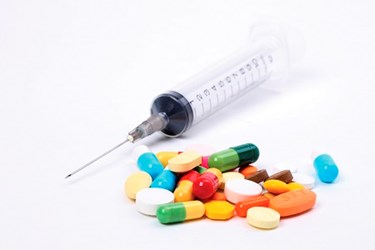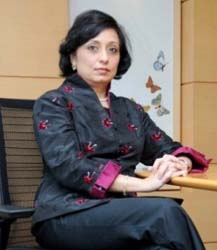Biogen: Embracing Biosimilars In A Biologics World

By Anna Rose Welch, Editorial & Community Director, Advancing RNA

When I sat down to talk with Biogen’s VP and head of the biosimilars business unit, Dr. Alpna Seth, I was looking for insights on the company’s strategy to make a name for itself in the slowly (but surely) growing biosimilar market. In the generics market, where strengthening portfolios and business is commonly accomplished by consolidation and acquisitions, I liked her answer: “We know how to do this stuff.” I admired her candor because it underscored that developing biosimilars — though still an emerging type of treatment in the E.U. and U.S. — is already a natural part of Biogen’s identity. It is this knowledge that led Biogen to jump into the biosimilar ring.
While it might seem that playing on both the biologics and biosimilars teams could lead to conflicting interests on the business level, Dr. Seth says this was far from the case. In fact, when evaluating the proposition, it seemed the company had what it needed to ensure success in the biosimilar field because of its biologics capabilities — especially for biosimilars of advanced, more complex biologics. After all, a number of companies in the industry, including Biogen, are choosing to focus on biosimilar drugs in addition to their blockbuster novel biologics — blockbusters that will face biosimilar competition in upcoming years. While biosimilars certainly pose a financial threat to reference biologics, these cost-effective alternatives are poised to be just as important to the growth of a company’s top-line.
 When it comes to making it in the biosimilar realm, Dr. Seth references the important role a company’s history, track record, credibility, existing manufacturing facilities, and technical development capabilities can play in developing biosimilars of advanced, complex biologics. In particular, she hones in on how manufacturing biosimilars at the same facilities with the same people and process capabilities used to manufacture originator biologics enables the company to supply the market consistently for the treatment of serious chronic diseases.
When it comes to making it in the biosimilar realm, Dr. Seth references the important role a company’s history, track record, credibility, existing manufacturing facilities, and technical development capabilities can play in developing biosimilars of advanced, complex biologics. In particular, she hones in on how manufacturing biosimilars at the same facilities with the same people and process capabilities used to manufacture originator biologics enables the company to supply the market consistently for the treatment of serious chronic diseases.
According to Dr. Seth, “There is generally a low level of awareness of the associated science and regulatory requirements for biosimilars, as well as how manufacturing defines the product. In Europe, where biosimilars have been on the market for a few years, this awareness is gradually increasing, and Biogen is working to demystify this.”
Part of the company’s strategy involved reallocating resources to the biosimilar division. For instance, the company deployed some of its best scientists who had extensive experience working with new cell lines and process improvement into the biosimilar unit. This ensured the division would be supported by employees who had dealt with similar challenges. This also translates to commercialization. As Dr. Seth says, “This is a new frontier for science, and it’s a new frontier when it comes to commercialization. There is very little precedent.” With a combination of internal and external talent on the commercialization side, Seth argues the company will be better able to figure out strategies that will best suit the biosimilar space.
Assembling The Portfolio, Assessing Markets
Biogen, with Samsung Biologics, has formed the joint venture Samsung Bioepis to develop several biosimilars, including anti-tumor necrosis factor (anti-TNF) biosimilars for Enbrel, Humira, and Remicade. Biogen holds the commercialization rights to all three of these biosimilar candidates in Europe, as well as rights for some of these future products in Turkey, Russia, and Japan. When it comes to deciding to pursue biosimilar development, Dr. Seth says to pay close attention to the company’s strengths. “A company should take into account a number of considerations when looking at biosimilar targets for development, including:
- Do the targets fit into the company’s area of expertise and strategic interests?
- Does the company have the necessary development, manufacturing, and supply capabilities to bring these therapies, especially advanced biologics for chronic disease, to market reliably?
- Is there ample regulatory clarity to make the commercial pursuits viable and unobstructed in the geographies the company pursues?
- Does the target’s IP time line and market potential make for a viable candidate (short or long term)?
But beyond candidate selection, it also comes down to determining the target market. For Biogen, the European regulatory pathway offered the greatest opportunity because it is more established than the U.S. pathway. However, it’s also important to note the varying ways European countries are approaching biosimilars. For companies entering the biosimilar space and determining the appropriate market, it’s important to examine the market dynamics in each country and how each country operates. For example, it’s important to evaluate which buying mechanisms are currently in place for biosimilars and how they are changing. These factors are all going to be different from country-to-country, Dr. Seth says.
The fact that countries across Europe each take their own unique approach to industry policies and regulations could be daunting for companies approaching the biosimilars market there. Dr. Seth notes, “The EMA is leading the way and has established a clear regulatory pathway for biosimilars. The first wave of biosimilars has been available in Europe since 2006. In 2013, the first antibody biosimilar was approved. Though there is sufficient regulatory clarity at the EU level to launch products, the EMA has left matters such as interchangeability and auto-substitution to the national authorities. I wouldn’t say that there is one trend that just applies to every country, but people are watching. They’re paying attention. I think fast forward two or three years, a lot of change will happen.”
Embracing Biosimilars As Innovation
For companies approaching the biosimilar market, Dr. Seth stresses the importance of remaining flexible and “nimble in order to respond to unexpected twists and turns along the way.” Ultimately, the biosimilar space is expected to be a key to more affordable healthcare. However, Dr. Seth warns against comparing the biosimilar market to that of the generics market. Not only are biosimilars more expensive to develop and manufacture than small molecule generics, they are not identical and must follow a robust pathway to determine safety and efficacy. She adds, “If there is a push toward commoditization like generics, then this will not be sustainable, especially considering the cost of biosimilar development.”
While biosimilars stand to threaten many reference companies’ blockbuster biologics, Dr. Seth expresses only admiration for the emerging market. To her and to Biogen, these “copycat” medicines, as they’re often called, demand just as much respect as manufacturing a new molecule. Dr. Seth argues, “Coming up with a high-quality, highly biosimilar product is at least as challenging, if not more challenging, than technical development of a new product. You have to reengineer it on your own, and you have to somehow come up with a process that produces a product that is highly biosimilar. It’s not just a science, it’s also an art in terms of biologics process development and manufacturing.”
